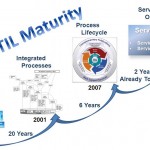Service Value is the Next Generation!
Time for ITIL. Year-end is always a good time to watch the predictions fly and I too had to add 4 to my friend Richard Whitehead’s post with his top 10. In my post I made a prediction that this would be the year that ITIL begins to wane as a topic of conversation for a couple of reasons. Last week reinforced one of those beliefs with a CIO article I commented on, “ITIL versus the Cloud: Pick One”. Even this week, I still cannot wrap my head around this article and this is where my reasons for ITIL waning is deeply rooted.
First, I will mention I have been ITIL Foundation certified 2 times (version 2 and version 3) and was around in the service desk world during the days of all the little books for version 1. Yes, I started working when I was 12. Seriously, ITIL is prescriptive, not a remedy. It is guidance about processes, not a mandated set of principles by which to govern an IT organization to the point of suffocation. I have done my fair share of consulting and once folks get past the hurdle that it is merely advice, adapt it to what makes sense in their environment without suffocating, then the sessions are more successful. However, I find that ITIL is one of those topics I would rather not discuss in mixed company, much like politics or religion, as it brings out very passionate debates and you need to know the party lines to consult.
Why do I believe it is really waning, it’s an inward facing operational process that is expected, it is a consulting and training industry. Business doesn’t want to hear about how you do your job, just that you do it, do it well and do it efficiently. It’s like this, as consumers we take our cars to the shop for routine maintenance and fixes when things break and what we are most interested in is how much will it cost and when will it be done. We don’t really care what processes and procedures the mechanic follows or how many certifications he/she has to perform the job, we just care he/she can do the job, do it well and cost efficiently. So why is it as IT professionals we go to work everyday and speak jibberish to our business colleagues?
I would find it a safe bet that your business would love to hear you come in and tell them exactly how implementing an updated service, a new technology, or automating a process will reduce XYZ cost, will drive XYZ additional revenue and this is how we will monitor Service Performance mitigating risk of service impacting events. Just as this article implies, ITIL is very silo focused still. Sure version 3 speaks of a service lifecycle, lifecycle not so much on the service performance and value to the business.
Here is a picture to help explain, click on it to enlarge it. ITIL is going through a process maturity as well. Here are the stages:
- version 1 – Processes Identified as individual processes
- version 2 – Processes Integrated
- version 3 – Process Lifecycle
- version 4 – still to come and already too late

I’ll end with this, I’m not against ITIL if it is taken as a prescription, training, examples. However, when it becomes the way we speak to our business and customers and our sole focus, I find it like new technology for the sake of technology. When I read articles about How to Justify an ITIL Project to the Business, I know the service providers are knocking on your door to take over your data center because they speak in terms of creating efficiencies, saving money and driving revenue.
We have lost all focus when we start speaking in terms of a new technology not fitting ITIL and choose one. In that situation, I’d leverage new technology and work to service enable it to manage it, control it and communicate the value it is delivering to the organization over ITIL as it is, again, merely training, prescription and examples
The only thing I can guarantee is change and technology evolution are sure things. As technology professionals, we must be seeking automation, technology and methods by which we can start communicating to our business in their terms. Communicating Service Performance, Growth and driving Value into our businesses is the focus of those that lead their industries with technology.
I believe the explosion of cloud computing and the service provider market will be the catalyst described by Nicholas Carr’s article, “IT Doesn’t Matter”.
I know this controversial, give me your thoughts!
Michele



